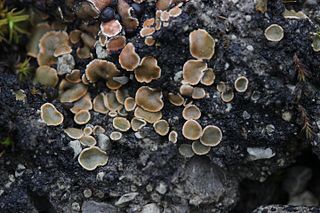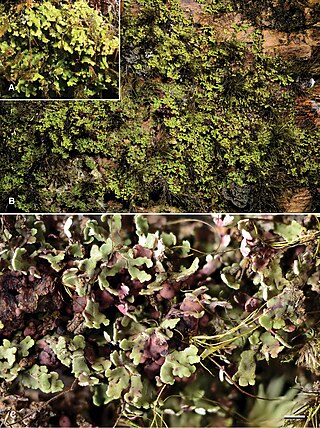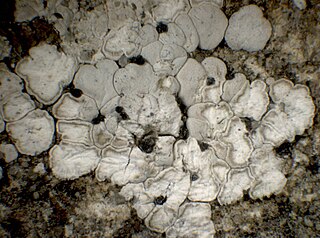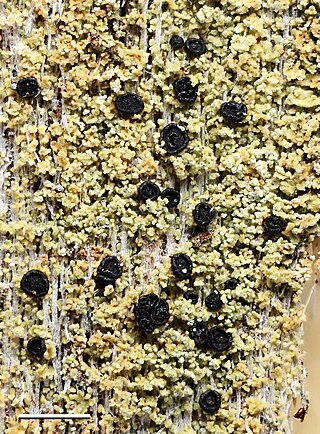
Psora is a genus of lichen-forming fungi in the family Psoraceae. Members of the genus are commonly called fishscale lichens. Lichens in the genus Psora generally have a squamulose thallus and anthraquinones in the hymenium. Photobiont partners of Psora lichens include members of the green algal genera Asterochloris, Chloroidium, Myrmecia, and Trebouxia.
Crustospathula is a genus of five species of crustose lichens in the family Malmideaceae. They are characterized by their stalked and sometimes branched cartilaginous soredia and Bacidia-like apothecia.

Toniniopsis is a genus of crustose and squamulose lichens in the family Ramalinaceae. The genus was circumscribed by Swiss lichenologist Eduard Frey in 1926, with Toniniopsis obscura designated the type and only species. The genus name of Toniniopsis is in honour of Carlo Tonini (1803–1877), who was an Italian chemist and botanist (Lichenology), who worked in Verona and was a member and President of the Academy of Agriculture. As a result of molecular phylogenetic studies, several species, formerly classified in genus Bacidia, have been transferred to Toniniopsis.

Calvitimela is a lichen genus in the family Tephromelataceae. Members of the family Tephromelataceae are crustose lichens with green photobionts and lecideine or lecanorine apothecia. The species in Calvitimela have lecideine apothecia, are saxicolous and are primarily found in alpine to arctic regions.

Pycnora is a genus of fungi in the monotypic family Pycnoraceae. It contains three species. The genus was circumscribed by Josef Hafellner in 2001; the family was proposed by Mika Bendiksby and Einar Timdal in 2013.
Bibbya is a genus of fruticose lichens in the family Ramalinaceae.

Sporastatiaceae is a small family of crustose lichens in the order Rhizocarpales. It contains two genera, Sporastatia and Toensbergia, with a total of five species. Sporastatiaceae was circumscribed in 2013 by Mika Bendiksby and Ernst Timdal.
Toensbergia is a genus of lichen-forming fungi in the family Sporastatiaceae. The genus was circumscribed by Mika Bendiksby and Einar Timdal in 2013. The genus name honours Norwegian lichenologist Tor Tønsberg, "in appreciation of his important work on sorediate, corticolous lichens". The type species is Toensbergia leucococca, which was formerly classified in genus Hypocenomyce, presumably due to its resemblance to Hypocenomyce xanthococca.

Carbonicola is a small genus of lichen-forming fungi. It is the sole genus in the monogeneric family Carbonicolaceae. The genus, which collectively has an almost cosmopolitan distribution, contains three squamulose lichens that prefer to grow on burned wood in temperate areas of the world.

Hypogymnia flavida is a species of foliose lichen in the family Parmeliaceae. It is found in mountainous locations of east Asia, where it grows on the bark and wood of woody plants. It has a relatively large yellowish thallus.

Psora taurensis is a species of terricolous (ground-dwelling), squamulose lichen in the family Lecanoraceae. It is found in the Taurus Mountains of Turkey.
Biatora oxneri is a species of corticolous (bark-dwelling) lichen in the family Ramalinaceae. It is found in the Russian Far East and in South Korea.
Phyllopsora amazonica is a species of corticolous (bark-dwelling), crustose lichen in the family Ramalinaceae. It is found in the Amazon rainforest of Brazil.
Phyllopsora concinna is a species of corticolous (bark-dwelling), squamulose (scaley) lichen in the family Ramalinaceae. Found in Central and South America, it was formally described as a new species in 2019 by lichenologists Sonja Kistenich and Einar Timdal. The lichen has a scaley, effuse (spread-out) thallus that is pale green with a well-developed, white prothallus. Apothecia occur rarely; they are brownish with a paler margin, measuring up to 1 mm in diameter. Ascospores are simple with a narrow ellipsoid to fusiform shape, and dimensions of 12.5–16·0 by 3.5–4.0 μm. Atranorin and parvifoliellin are major lichen products that occur in this species. The latter compound distinguishes it chemically from the morphologically similar species Phyllopsora cinchonarum, which instead contains lobaric acid. The botanical name concinna, refers to its "beautiful" appearance.
Phyllopsora neotinica is a species of corticolous (bark-dwelling), squamulose (scaley) lichen in the family Ramalinaceae. Found in North, Central, and South America, it was formally described as a new species in 2019 by lichenologists Sonja Kistenich and Einar Timdal. It is similar to Phyllopsora chodatinica, but unlike that species, it contains argopsin and often zeorin, but it lacks chodatin. The species epithet neotinica is a contraction of "neotropical" and Phyllopsora chodatinica.

Krogia macrophylla is a species of corticolous (bark-dwelling) lichen in the family Ramalinaceae. Found in New Caledonia, it was formally described as a new species in 2018. It is distinguished from other Krogia species by its relatively larger squamules and the production of a chemical substance similar to boninic acid. The species grows predominantly on tree trunks in moist or wet tropical forests.
Upretia squamulosa is a species of saxicolous (rock-dwelling), squamulose (scaly) lichen in the family Teloschistaceae. It was identified as a new species in 2019 from specimens collected in the arid valley of the Jinsha River in Yunnan, China.

Porpidinia is a genus of lichen-forming fungi in the family Lecideaceae. It has two species of saxicolous (rock-dwelling) lichens. The type species of the genus, Porpidinia tumidula, thrives in a variety of settings from coastal to mountainous areas, primarily on lime-rich rocks, and is widely spread across southern to northern Europe, northern Africa, parts of Asia, and New Zealand. Meanwhile, Porpidinia brevispora is more regionally confined, found specifically in the Sikhote-Alin range in the Russian Far East, favouring carbonate rocks at lower altitudes.

Xylopsora canopeorum is a squamulose (scaly), corticolous (bark-dwelling) lichen species in the family Umbilicariaceae. Discovered in the canopies of Sequoia sempervirens in California, United States, it was formally described as new to science in 2018. It is endemic to the central coastal region of California, living within the unique ecosystems of Big Basin Redwoods State Park and Armstrong Redwoods State Natural Reserve, areas known for their ancient coast redwood forests. The lichen evolves from a crust-like to scale-like form, developing into coral-like crusts as it matures, complemented by distinctive flat, black reproductive discs. This species has varying greyish-green to medium brown coloration and occasionally forms soralia, which release powdery reproductive propagules called soredia. Xylopsora canopeorum is distinguished from closely related species by its smaller, partly coral-like squamules (scales), the occurrence of soralia on its surface, and in some specimens, the presence of both thamnolic and friesiic acids within the thallus.
Fulgidea is a genus of lichen-forming fungi in the family Umbilicariaceae. It has two species of squamulose lichens that grow on bark and on wood.











